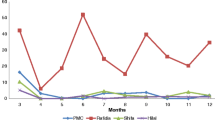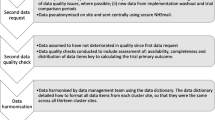Abstract
Purpose
The aim of this study is to report challenges encountered when conducting inter-institutional data collection of obstetric (prenatal and postpartum) and delivery outcomes for research purposes and to propose solutions for enhanced efficiency.
Methods
Data were collected from women who consented to collection of obstetric and delivery records for an observational study of pregnancy and delivery outcomes following infertility treatment. We analyzed key issues relevant to improving efficiency of obstetric and delivery data collection via quantification of effort (such as number of calls and faxes) required to obtain records from different types of obstetric clinics and hospitals before and after utilization of a revised authorization.
Results
At time of analysis, records were successfully collected from 320 of the 451 participants who had delivered. The 320 participants received obstetric care at 63 institutions and delivered at 27 hospitals, with 168 (52.5 %) delivering at institutions other than home facility. At time of consent (8 weeks gestation), 155 of 320 (48.5 %) correctly predicted where they would receive obstetric care and 176 (55 %) where they would delivery. Most facilities (nearly 90 %) rejected our original authorization, but most (90 %) accepted the revised authorization described in this manuscript.
Conclusions
Collecting records is time-consuming but important as over 50 % of our participants received care outside of the home facility. To efficiently collect outside records, we recommend that researchers interested in maternal and neonatal outcomes consider the guidelines outlined in this manuscript. This report also provides strong evidence of the need to develop data sharing through electronic health records for research purposes.

Similar content being viewed by others
References
Henningsen AK, Pinborg A. Birth and perinatal outcomes and complications for babies conceived following ART. Semin Fetal Neonatal Med. 2014;19:234–8.
Tepper N, Farr S, Cohen B, Nannini A, Zhang Z, Anderson J, et al. Singleton preterm birth: risk factors and association with assisted reproductive technology. Matern Child Health J. 2012;16:807–13.
Qin J, Liu X, Sheng X, Wang H, Gao S. Assisted reproductive technology and the risk of pregnancy-related complications and adverse pregnancy outcomes in singleton pregnancies: a meta-analysis of cohort studies. Fertil Steril. 2016;105:73–85.
Declercq E, Luke B, Belanoff C, Cabral H, Diop H, Gopal D, et al. Perinatal outcomes associated with assisted reproductive technology: the Massachusetts Outcomes Study of Assisted Reproductive Technologies (MOSART). Fertil Steril. 2015;103:888–95.
Pinborg A, Wennerholm U, Romundstad L, Loft A, Aittomaki K, Soderstr- rom-Anttila V, et al. Why do singletons conceived after assisted reproduction technology have adverse perinatal outcome? Systematic review and meta-analysis. Hum Reprod Update. 2013;19:87–104.
Baker VL, Brown MB, Luke B, Conrad KP. Association of number of retrieved oocytes with live birth rate and birth weight: an analysis of 231,815 cycles of in vitro fertilization. Fertil Steril. 2015;103:931–8.
Stern JE, Luke B, Tobias M, Gopal D, Hornstein MD, Diop H. Adverse pregnancy and birth outcomes associated with underlying diagnosis with and without assisted reproductive technology treatment. Fertil Steril. 2015;103:1438–45.
Davies MJ, Moore VM, Willson KJ, Van Essen P, Priest K, Scott H, et al. Reproductive technologies and the risk of birth defects. N Engl J Med. 2012;366:1803–13.
Pelkonen S, Hartikainen AL, Ritvanen A, Koivunen R, Martikainen H, Gissler M, et al. Major congenital anomalies in children born after frozen embryo transfer: a cohort study 1995–2006. Hum Reprod. 2014;29:1552–7.
Shankaran S. Outcomes from infancy to adulthood after assisted reproductive technology. Fertil Steril. 2014;101:1217–21.
Harbin Consensus Conference Workshop Group. Improving the reporting of clinical trials of infertility treatments (IMPRINT): modifying the CONSORT statement. Fertil Steril. 2014;102:952–9.e15.
Barnhart K. Live birth is the correct outcome for clinical trials evaluating therapy for the infertile couple. Fertil Steril. 2014;101:1205–8.
Silver R. Infertility trial outcomes: healthy moms and babies. Fertil Steril. 2014;101:1209–16.
Legro RS, Wu X. Introduction: choosing the main outcome of an infertility trial is harder than you think. Fertil Steril. 2014;101:1201–2.
Fernandopulle R, Patel N. How the electronic health record did not measure up to the demands of our medical home practice. Health Aff. 2010;29:622–8.
Vest JR, Issel LM, Lee S. Experience of using information systems in public health practice: findings from a qualitative study. Online J Public Health Inform. 2014;5:227.
Kho AN, Hynes DM, Goel S, Solomonides AE, Price R, Hota B, et al. CAPriCORN: Chicago area patient-centered outcomes research network. J Am Med Inform Assoc. 2014;21:607–11.
Health Quality Ontario. Electronic tools for health information exchange: an evidence-based analysis. Ont Health Technol Assess Ser. 2013;13:1–76.
Sung NS, Crowley Jr WF, Genel M, Salber P, Sandy L, Sherwood LM, et al. Central challenges facing the national clinical research enterprise. JAMA. 2003;289:1278–87.
Johnson T. 2013 Socioeconomic Survey of ACOG Fellows. In: HIPAA Authorization for Research. In: Educational Materials, Authorizations. U.S. Department of Health and Human Services: National Institute of Health. 2013. http://www.acog.org/-/media/Departments/Practice-Management-and-Managed-Care/2013SocioeconomicSurvey.pdf. Accessed 27 Jun 2015.
Clinical Research and the HIPAA Privacy Rule. In: HIPAA for Professionals. In: Special Topics, Research. In: Clinical Research Fact Sheet. U.S. Department of Health and Human Services: National Institute of Health. 2004. https://privacyruleandresearch.nih.gov/clin_research.asp. Accessed 14 Mar 2015.
Wa tanabe N, Fujiwara T, Suzuki T, Jwa SC, Taniguchi K, Yamanobe Y, et al. Is in vitro fertilization associated with preeclampsia? A propensity score matched study. BMC Pregnancy Childbirth. 2014;14:69.
Hsiao CJ, Jha AK, King J, Patel V, Furukawa MF, Mostashari F. Office-based physicians are responding to incentives and assistance by adopting and using electronic health records. Health Aff. 2013;32:81470–7.
Charles D, Gabriel M, Furukawa MF. “Adoption of electronic health record systems among U.S. non-federal acute care hospitals: 2008–2013”, ONC data brief, no. 16. Washington, DC: Office of the National Coordinator for Health Information Technology; 2014.
Furukawa MF, King J, Patel V, Hsiao CJ, Adler-Milstein J, Jha AK. Despite substantial progress in EHR adoption, health information exchange and patient engagement remain low in office settings. Health Aff. 2014;33:91672–9.
Edwards A, Hollin I, Barry J, Kachnowski S. Barriers to cross-institutional health information exchange: a literature review. J Healthc Inf Manag. 2010;24:22–34.
Acknowledgments
The authors would like to thank all participants, prenatal/postpartum facilities, and delivery hospitals that enabled the collection of these data. This study was funded by Award Number P01 HD 065647-01A1 from the National Institute of Child Health and Human Development. Frauke von Versen-Hoeynck was funded by the German Research Foundation (VE490/8-1).
Author information
Authors and Affiliations
Corresponding author
Ethics declarations
Conflict of interest
The authors declare that they have no conflict of interest.
Ethical approval
All procedures performed in study involving human participants were in accordance with the ethical standards of the institutional and/or national research committee and with the 1964 Helsinki declaration and its later amendments or comparable ethical standards.
Informed consent
Informed consent was obtained from all individual participants included in the study.
Additional information
Capsule
To efficiently collect outside records, we recommend that researchers interested in maternal and neonatal outcomes consider the guidelines outlined in this manuscript.
Electronic supplementary material
Below is the link to the electronic supplementary material.
Supplementary Figure 1
(DOCX 84.5 kb)
Rights and permissions
About this article
Cite this article
Floyd, E.G., von Versen-Höynck, F., Liu, J. et al. Collection of pregnancy outcome records following infertility—challenges and possible solutions. J Assist Reprod Genet 33, 993–999 (2016). https://doi.org/10.1007/s10815-016-0733-1
Received:
Accepted:
Published:
Issue Date:
DOI: https://doi.org/10.1007/s10815-016-0733-1




